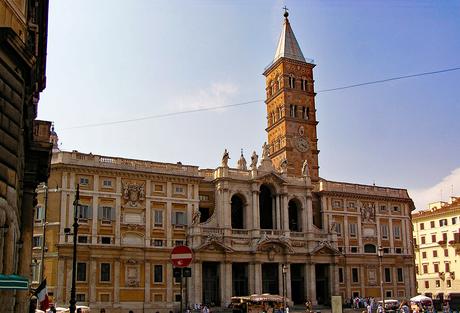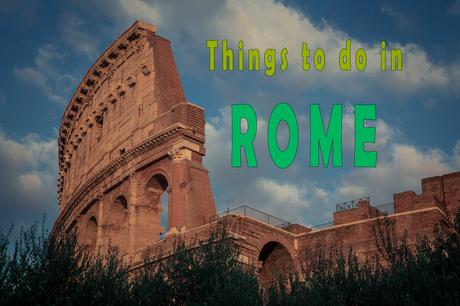
This article is for you, if you have never been in Rome before and looking for things to do in Rome for your first visit in this “Eternal City”. Rome has been a center of power and politics for about 2500 years. And because of this, its influence reached from north England to North Africa. But also from Portugal to the west parts of the Arabian Peninsula. Several Roman emperors have ruled the “divine city” (or shall I say Roma Divina Urbs). And of course, some of its inhabitants wanted to leave their own “footprints” to remain “alive” in the heads (and sometimes hearts) of the people. As Rome was in decline, a lot of those splendid constructions were dismantled by its own citizens. But luckily, a lot of them survived you can admire nowadays. So read on, folks and let’s explore the best things to do in Rome!
First of all, buy a ticket for a Hop-on Hop-off tour
Before we start, an important notice, folks. Not all of them, but a lot of those things to do in Rome which I’ll show you, you can easily reach when you buy a ticket for the Hop-on Hop-off bus*. Doing this, you will get a means of transportation for a flat rate price and will save money! So click of one of the links in this text or on the ad to buy a Hop-on Hop-off ticket. And now, let’s start with the best things to do in Rome.
Colosseum
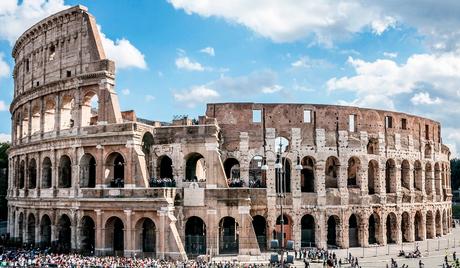
Who doesn’t know this mighty construction? I think, there are scarcely people on this planet who never heard about the Colosseum. It’s one of the most known places in the world, and not visiting the Colosseum, your trip to Rome wouldn’t be complete. The Colosseum was erected between the years 70 – 80 AD and was in usage for about incredible 450 years! Just during between the years 217 – 238 AD, there were no events. The reason for this was a lighting strike and then, the Colosseum had to be renovated. It’s assumed that this construction could hold about 80.000 spectators watching gladiator fights (but also fights between exotic animals).
How to get there: You should buy a Hop-on Hop-off ticket as the bus stops directly at Colosseum.
Entrance fee: I recommend you strongly to buy your tickets online as there is an incredible long line, and you would wait at least two hours (or maybe longer) for a ticket. Additional to this, when you decide to buy a ticket on-location, it could happen that the tickets are sold out (during the high season).
So when you buy online, you would be able to skip the line. The name of this ticket is “priority ticket” and it’s also a combo ticket. With it, you will additionally get an entrance to the Forum Romanum and the Palatin (more about them below).
Check the current prices and different options for the Colosseum here, folks:
Arch of Constantine
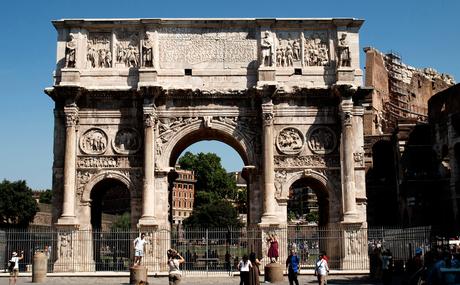
This arch was dedicated to the Emperor Constantine to celebrate his victory at the Battle of Milvian Bridge against his antagonist Maxentius on 28 October 312. This battle is also marked as Constantine’s beginning of conversion to Christianity. At least, the chroniclers Eusebius and Lactantius stated that Constantine and his soldiers as well had a vision sent to them by the Christian God. They understood it as a promise to lead them to victory when Constantin and the soldiers painted the first two letters of Christ’s name in Greek on their shields.
Long story short: they did and they won. From that point, the Roman Empire began slightly to convert to Christianity.
The Arch was finished in the year 315 AD but the interesting thing is that the decorative material contains a lot of work of previous emperors, like Trajan ( 98 – 117), Hadrian (117 – 138), or Marcus Aurelius (161 – 180).
Maybe that’s the reason for the controversy amongst the scholars over the origins of the arch. Some of them claiming that this construction wasn’t built by Constantine. It’s rather an earlier work from the time of emperor Hadrian, and it was just reworked during Constantine’s reign so the scientists.
Anyway, it’s a great construction from the Roman times, and it’s worth to stop in front of it just to admire this work.
How to get there:
Luckily, the arch is located adjacently to Colosseum, so you wouldn’t miss it, folks. There are also no admission fees.
Forum Romanum
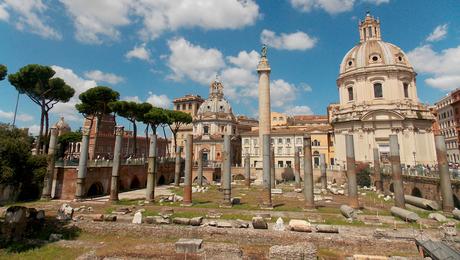
Maybe one of the most important Roman ruins in the whole country: the Forum Romanum: It’s an ancient site consisting of many ruins. But back those days, this was the center of the Roman public life and political events.
Due to its central location hardly imaginable, excavations have shown that the entire area of Forum Romanum was built on a swamp. Until the year 600 BC, the area was not really in use until the first buildings were erected here. When with the kings palace the first building was built, the forum evolved gradually into the most central place with many new facilities.
During the heyday of the Roman Empire, this place had a high density of various temples, squares and arches. One of the most known temples: The Temple of Saturn, Titus and Vesta and the Arch of Severus.
How to get there: The good thing is that the Forum Romanum is located next to the Colosseum, so you will be able to visit two places close to each other.
Entrance fee: When you buy a ticket to the Colosseum, you will automatically get an entrance permission to the Roman Forum as this would be a combo ticket. Again, I strongly advise you to buy the tickets online unless you want to wait in line at least two hours. And believe me, it’s not fun at all because Rome is a hot place even in the autumn.
Palatine Hill
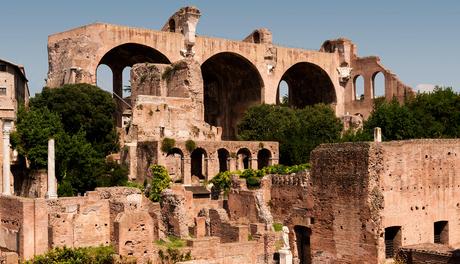
The Palatine Hill is also one of the most ancients areas in Rome, and it stands about 40 meters above the Roman Forum. Obviously, at this place were the origins of Rome because excavations showed a collection of huts which were used already in the 9th century BC for funerary purposes!
According to Roman mythology, the Palatine Hill was also the place of the cave where the she-wolf found the twin brothers Romulus and Remus. If you are familiar with this legend, you surely know that Romus killed Remus and afterwards, he went on to build the city of Rome and became the first king of Rome.
There are still some structures are standing on the Palatine Hill including the palace of Flavian and the Temple of Cybele.
Check this video about the Palatine which describes this attraction in Rome pretty well:
How to get there: When you visit the Colosseum and Forum Romanum, you will automatically get to the Palatine Hill (if you want).
Entrance fee: when you buy a ticket to the Colosseum and Forum Romanum, the admission to Palatine Hill is included.
Circus Maximus

This arena was the main venue of the games in Rome and is still a term for many movie fans – thanks to Ben Hur. The remains of this huge ancient structure with a length of about 600 meters (apprx. 1970 ft) and a width of about 150 meters (apprx. 495 ft) you can still visit today. Unless Bruce Springsteen or the Rolling Stones have a gig there…
The Circus Maximus was built on drained swamps already in the 6th century BC. But even before, there was a racecourse on this place. When Julius Caesar came to the fore, he expanded Circus Maximus in the year 50 BC. Hence, it received an imperial lodge, and an obelisk was brought from Egypt and was set up. Later, another one was erected there, too. In other words, at Circus Maximus, Caesar offered the Romans “bread and circuses”.
Later, in the year 81 AD, there was a triumphal arch erected in honor of Emperor Titus. After this, the arch became the entrance to the Circus Maximus, because the old entrance was built of wood and burned down three times.
But under Julis Caesar, there were no grandstands. They were built much later in the year 103 AD by Emperor Trajan, and they were cladded with marble. At the end, there was a three-storey building with a magnificent interior. Shops, betting “offices”, brothels and inns were available for up to 150,000 spectators.
Bonus information: The Colosseum is a very famous attraction in Rome. But only few people know that the Colosseum was actually the “little brother” of Circus Maximus. The reason for this is that the Colosseum was not the main venue for the gladiator games and other activities in Rome. It was Circus Maximus!
At this place, there were up to 20 daily horse races and other events like gladiator fights. In the Colosseum, there were annually just 4 events held…
Also, Circus Maximus was the place for religious events to honor the Roman gods. But no one advertises with those topics nowadays. Why? The reason is simple: with gladiator fights and horse races you can attract more people and earn more money. That’s how it was back those days, and today, it’s the same.
What will you get there
There is not much left of the Circus Maximus. What a bummer, because this construction must have been very impressive and magnificent. Unfortunately, you can not see much more than a large meadow today. However, the ground view can be still guessed under the grassy hills.
When the St. Peter’s Basilica was built, the marble seatings were used for it as building material. So if you visit the Basilica, you can also visit a part of history of Circus Maximus. The two obelisks were dismantled. The one of them stands today close to the Archbasilica of Saint John Lateran, the second one at the Piazza del Popolo. More about the Piazza you will find below.
Nevertheless, many tourists visit the remains of the Circus Maximus every year and are thrilled with the extent of the arena. In summer, the Romans like to spend their evenings there with a good wine and friends. For jogging and dog walks, the area is also used frequently.
But also concerts and other major events you can visit at this place. In 2014, the Rolling Stones performed in this historic arena in front of more than 70,000 fans. In July 2016, it was Bruce Springsteen who brought thousands of fans together at the Circus Maximus.
How to get there:
The Hop-on Hop-off bus* has a stop there so you can easily visit this place after you’ve visited the Colosseum and Forum Romanum
But from Colosseum, you can also walk there as it’s not far away. Click here to start the navigation, folks.
Entrance fee: it’s for free, and you can visit this place 24/7.
St Peter’s Square
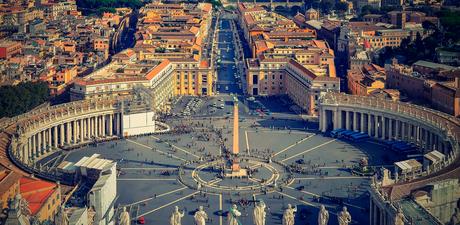
The smallest country in the world is located not elsewhere but in Rome. The name of this country is Vatican which is one of the most important catholic places in the whole worl.
And the St. Peter’s Square is the place where many important religious events have taken place. This square is located just at the front of the Vatican and although it’s called a square, this place is actually circular and it’s framed by two long sets of colonnades.
On those colonnades, there are a lot of religious figures, and previous popes are placed which you can admire when you enter St. Peter’s Square. In the center of the square, there is an imposing Egyptian obelisk. Previsously, the obelisk was located at the Circus of Nero and was moved to the St. Peter’s Square in the year 1586.
How to get there:
The Hop-on Hop-off bus stops not far away from the St Peter’s Square so would have to walk for about 10 minutes to this place. Click here to navigate there.
Entrance fee: it’s for free
St. Peter’s Basilica
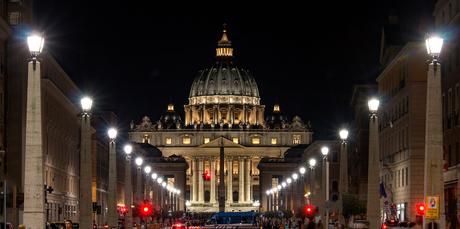
The probably most celebrated religious building in the world, St. Peter’s Basilica, stands as a triumph to the power and decadence of Catholicism. Some might say, it’s contrary to the spirit and what the Bible is teaching. But hey, that’s how the things are, and at least, you have now the possibility to have one more of the things to do in Rome, right?
But how did this place become such famous? On the historic hill called “Mons Vaticanus” a pilgrim church was built in the 4th century in honor of Saint Peter. Allegedly, he was crucified and buried under the reign of the Roman emperor Nero. Whether this is true or not, there is no real evidence to this day.
But the religion of the Christians which was about to become state religion under Emperor Constantine, needed in its early days its own symbols, its own ceremonies and strong identification figures to compete against the Roman godheads. Until the 15th and 16th centuries, the pilgrim church was a historical and religious heritage of the Constantinian age.
But the popes of the Renaissance were not only guardians and leaders of the Christian religion, but they were also greedy for power and influence. And this potential should manifest itself in their buildings. Thus, Pope Julius II demolished the dilapidated pilgrim church in the year 1506 to commission a new building. Nobody guessed at that time that it would take 120 years to complete the construction of the new church. And this was at the time when the church rulers could finance their building programs by selling of indulgences.
When the building was finally completed in the year 1626 and inaugurated by Pope Urban VIII, one of the largest church constructions in the world was now located in the middle of Rome which can accommodate up to 20,000 people. The interior, consisting of 800 marble, bronze and stucco columns, houses 44 altars and numerous artistic treasures such as the Michelangelo’s Pietà. To this day, the Pope holds the service in this basilica.
Entrance fee: the entrance is for free as every religious place in Italy. But inside of the church, there is also the Vatican Museum located where you need to pay in case you would like to visit this place. More about the museum you will find in the next section.
Note: Before you can enter St. Peter’s Church, you will need to pass a procedure like at the airport. Put your belongings on the conveyor and walk through the metal detection.
Vatican Museums
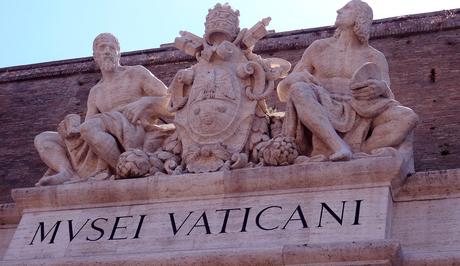
This treasury of classical and historical art has been built up over many centuries by various popes. In total, the Vatican Museums hold more than 70.000 pieces of art. The collection is one of the largest in the world. It includes items from ancient Egypt and classical antiquity as well but also art from the Renaissance and the periods up to the 19th century.
The museums consist of several areas, e.g. Museo Pio-Clementino, the Museum Chiaramonti, the Museo Gregoriano Etrusco and the Museo Gregoriano Egiziano. Each of those museums contains different artworks. But they also consist of the Pope palaces, Sistine Chapel (more about it below), etc.
You can buy a combo ticket to see both the museums and the Sistine Chapel as well. I recommend you plan a bit more time to visit both attractions properly.
Entrance fee and waiting time:
Apart from the Galleria Borghese (more about it you will find below), there are two other attractions in Rome for which you should book your tickets in advance: the Colosseum and the Vatican Museums. Due to its popularity, it’s normal that the waiting times in the high season (about March to the end of October and in December) at the entrance can take about three hours.
In the forenoon you would also stand in the sun, which is very nice at the beginning, but after three hours it’s quite uncomfortable. If you buy your tickets in advance, you will not have the problem because you would skip the line and start the tour immediately.
The priority tickets without waiting time are about 10,- EUR more expensive than the regular tickets, but the time saving is enormous.
Sistine Chapel
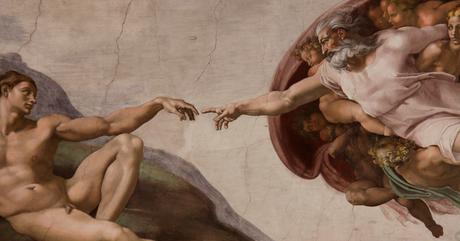
As a part of the Vatican museum complex, the Sistine Chapel is one of the most famous chapels in the world due to its stunning amount of detail and iconography.
Since Dan Brown’s thriller “Angels & Demons”, the Sistine Chapel is today as well known as St. Peter’s Basilica. This place, where the popes are elected, is one of the most popular attractions of Rome.
Originally, the Sistine Chapel was known as the Cappella Magna (‘Great Chapel’). Later it got its new name from the Pope Sixtus IV, who restored it between the years 1477 and 1480. Since then, the chapel started to serve as a place of both religious and other activities. The fame of the Sistine Chapel lies in the frescos and most particularly in its ceiling paining “The Last Judgment” by Michelangelo.
How to get there: The Sistine Chapel is located within the Vatican Museums, and there is no extra entrance. Usually, there are no waiting times at the entrance to the chapel, although it is occasionally a little bit fuller than usual.
Entrance fee:
There are no extra tickets needed for the visit of the Chapel. When you visit the Vatican museums, you will automatically be able to visit the Sistine Chapel. But you have to expect long waiting times at the entrance to the Vatican Museums. At the peak times (high season, December and weekend), you have to stand in the line like 2 to 3 hours. To avoid long waiting times, I strongly recommend you to buy your ticket in advance online.
Castle Saint Angelo
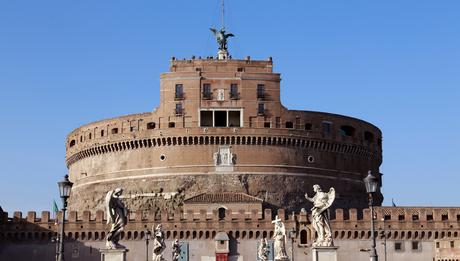
This castle is a circular fort but also a castle complex dedicated to the emperor Hadrian. That’s why this place is also known als the Mausoleum of Hadrian, folks. It was built in the year 129 AD and orignally, it was the tallest building in Rome. With the time passing by, Saint Angelo became part of Vatican and was linked to St. Peter’s Basilica by the so-called Passeto di Borgo which is a 800 m (2600 ft) long corridor. This corridor was erected in the year 1277 by the Pope Nicholaus III.
From outside, Passeto di Borgo looks like just a normal and boring wall. But you can walk on the top of this wall, protected by merlons. The reason for this corridor was the idea to flee from Vatican to the impregnable Castle Saint Angelo in case the clergy or the Pope was in danger.
And indeed, there were two known occasions when Passeto di Borgo could be helpful for the Pope Alexander IV in 1494 and Clement VII in the year 1527.
The Pantheon
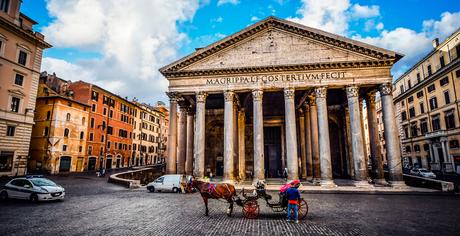
Pantheon, one of the best preserved Roman buildings and one of Rome’s most popular attractions. It was erected in the year 118 AD by the emperor Hadrian.
As its name implies, the Pantheon was built for all gods: the Greek words “pan” stands for “all” and the “théos” means “gods”. Accordingly, the Greek name stands for the totality of all godheads. In addition, the Pantheon was built on the Campus Martius, a field which was dedicated to the Roman god of war Mars. This field was used as a sheep and horse pasture, as long as the military did not needed it for training purposes. But Pantheon is the successor of a previous temple, which Marcus Vipsanius Agrippa had built at the same place. However, during a fire in the year 80 AD, the original temple was damaged and subsequently restored. In 1100 AD, the building burned down again as a result of a lightning strike. But the Romans didn’t give up and rebuilt the Pantheon in the 2nd century AD which you can now admire when you are looking for things to do in Rome. It was the emperor Hadrian who commissioned the restauration of Pantheon. How long the Pantheon in Rome has been used cultically, can not be determined precisely due to the lack of literary sources. But under the rule of the emperor Honorius, the temple service must have been finally stopped by the beginning of the 5th century AD. Later, in the year 609 AD, Pantheon was consecrated to a Christian Church and got an official Christian name which is Santa Maria ad Martyres. But today, nobody does it really know, I guess. That’s why you still know this place as Pantheon.How to get there:
The Pantheon is located in the center of Rome where no Metro, no Hop-on Hop-off bus, or other public transportations can drive through. But when you’ve got a ticket for the Hop-on Hop-off bus, you could leave at the station where you would go to the St. Peter’s Square and Castle Saint Angelo. From those attractions, you could stroll to Pantheon and on the way explore the city through narrow alleys. Click here to navigate to the Pantheon.
Entrance fee: as a religious place, the entrance for the Pantheon is for free
Trevi Fountain
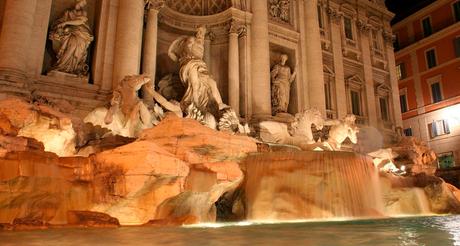
The world-famous fountain of Rome, with a width of just about 50 meters (apprx. 164 ft) and a height of 26 meters (apprx. 85 ft), has charmed Romans and tourists since its completion in the year 1762. This construction was commissioned by Pope Clement XII. For this task, he surprisingly chose a pretty unknown architect called Nicola Salvi.
Salvi began in the year 1732 with the planning and the building. But he wasn’t the witness of the completion of his work, as well as the client himself. For Salvis passed away in the year 1751 and Pope Clement XII in the year 1740. Then, Giuseppe Pannini took over the coordination of the work, while Pope Benedict XIV followed Pope Clement XII.
Since Salvi and Pannini used travertine for the Trevi fountain from Tivoli and also marble from Carrera, the fountain is not just an eye-catcher, but has survived more than 250 years since its completion.
However, the traces of time, reinforced by numerous vandalism attacks, could not spare the building fully so that over the decades, several renovations were necessary. Most recently the fountain was renovated in the years 2014 and 2015. Due to the newly inserted lighting elements, visitors now have a small spectacle of light after the dawn, in addition to the waterworks.
How does the Trevi Fountain look like?
The fountain is arranged in the style of a stage and in the style of a triumphal arch. It also has a multitude of statues, archways and columns. Also, it’s integrated into the back facade of Palazzo Poli.
The central statue is the god of the sea, Neptune, perched on a kind of chariot shaped like a shell. He is surrounded by seahorses, tritons and other mythical creatures. On both sides of the Neptune, there are niches with more statues intended to symbolize fertility and health, created by Filippo della Valle.
Throw some coins into the water of the Trevi Fountain
There is a tradition to throw some coins into the water of the fountain.
According to the tradition, dropping one coin into the water means that you will return to Rome. If you throw two coins into the water, you will fall in love with an Italian. There is another belief that says that a wish comes true when you throw two coins into the water. If you are willing to “donate” a third coin, you will marry the Italian you fell in love within a year.
It is important that you throw the coins turned with your back to the well, either with the left hand over the right shoulder or with the right hand over the left shoulder.
Believe it or not, but the tourists are throwing such eagerly the coins into the water of the Trevi fountain, that the government of Rome collects about 1 Million Euro annually! But it doesn’t keep the money but it’s donating it to charitable organizations such as Caritas or using it for historic preservation purposes. So if you ask me, this is not just one of the fun things to do in Rome but in this case also a useful one.
How to get there:
If you are on the way in the center of Rome, you can easily walk to the Trevi Fountain. In case you have a ticket for the Hop-on Hop-off bus, you can leave the bus at the Piazza Barberini and would need just a couple of minutes to the fountain. Click here to navigate there.
Spanish Steps
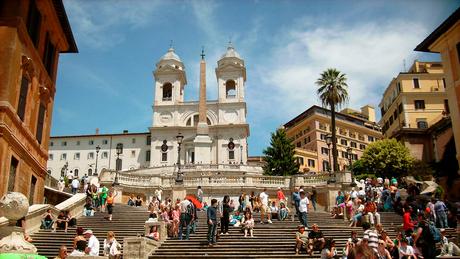
Another great attraction in Rome which was built in the year 1725 to span the gap between the popular places Piazza di Spagna and the Piazza Trinita dei Monti. Each of the 135 steps has a wide stone ledge and at the top of the Spanish Steps you will find a large obelisk with many inscriptions.
There are many different places in Rome that allow a direct insight into the history of the building due to their original Latin name. This is a bit more complicated at the Spanish Steps. On the one hand, the story suggests that the staircase should be named after the French. After all, they were the ones most likely to be involved in the construction.
The fact that at the end it was Spain that gave its name to the famous building lies in Piazza di Spagna. For the Spanish square is where the stairs end. Its name comes from the Spanish Embassy, which was located here beforehand. Therefore, it was decided that this name would be suitable for the stairs. And this name was kept even when the Spanish embassy wasn’t there anymore.
By the way: The Spanish Steps are called like this only outside of Italy. Taxi drivers in Rome immediately recognize tourists when they say “Spanish Steps” or “Spanish Stairs” as their destination in English. If you do not want immediately expose as a tourist, you should rather say “Piazza di Spagna” or “Scalinata dei Triniti dei Monti”. That’s the actual name of the stairs in Italy!
Piazza Navona
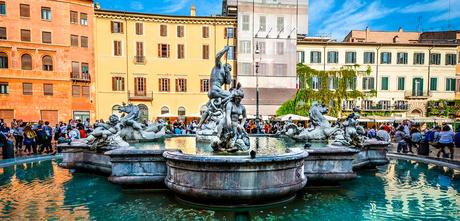
Piazza Navona is located not far away from the Pantheon and Trevi Fountain as well, and it impresses with an elongated-oval shape. In the name of Emperor Domitian, the Romans built here a sports field for the sports competitions of the Greek athletes. Because the competitions seemed to be immoral to the Romans, the closer vicinity, apart from the surrounding tribunes, was not further developed.
A circumstance that changed in the Middle Ages as rich Romans moved into the area of Piazza Navona and surrounded the square with their buildings so it became a classy Baroque park until the 17th century. One of the great attractions to see at the Piazza Navona is the family palace, the church of Sant ‘Agnese and the elaborate wells.
At the end of the 15th century, when the upper class of Roman society settled down in Piazza Navona and had already erected remarkable buildings, it decided to add even more classiness. This famous fountain was the result of those endeavours.
This fountain was designed in the year 1651 for the pope Innocent X by the Italian sculptor Gian Lorenzo Bernini. The base of the fountain consists of a basin and four sculptures symbolizing the four river gods who are The Nile, The Ganges, The Danube, and the Rio de la Plata. Each of those rivers stands for a continent – Africa, Asia, Europe, and the both American continents. In the middle of them, there is a copy of an Egyptian obelisk with the symbol of the dove which was the emblem of the Popes family Pamphili.
This fountain has always been a popular attraction in Rome. But I think, since the movie “Angels & Demons” with Tom Hanks, this place became even more famous. For this fountain was the scene when this bad guy tried to drown one of the kidnapped cardinals.
Galleria Borghese
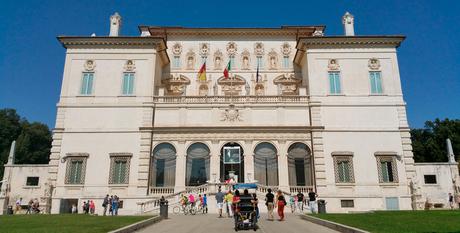
Galleria Borghese is a famous and important art museum with tons of paintings, sculptures and antiques. The museum was established in the year 1903 but the building itself was erected in the 17th century. At this time, the ground of the villa was outside of the walls of Rome and therefore, it was used as a so-called “villa suburbana”, or a country-villa close to Rome, if you will.
But why Borghese? Because the Cardinal Scipione Borghese started to collect paintings, sculptures and antiques in the late 16th or early 17th century. His legacy is now what you can visit and admire in the gallery.
The museum includes twenty rooms spread over two floors. At the first floor (called Salone) you will find mostly classical antiquities from the 1st to 3rd centuries AD, and some classical and neo-classical sculptures.
How to get there:
When you visit the Spanish Steps, it would be just a stone’s throw to the Galleria Borghese. Click here to navigate there, folks.
Opening hours and entrance fee:
The Galleria is open from 8:30 a.m. to 7:30 p.m. from Tuesday to Sunday. The entrance fee is 15,- EUR for adults, 8,50 EUR visitors between the age of 18 and 25. Visitors younger than 18 years will have to pay 2,- EUR.
The tickets are valid for a specific time as the museum is always well visited. Therefore, I recommend you to buy the tickets for the Villa Borghese in advance.
In this case, they would be a bit more expensive. But you will save a lot of time by skipping the line.
Villa Borghese Gardens
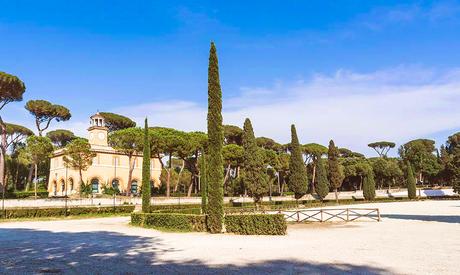
Originally, the Galleria Borghese was a part of the Borghese Complex and thus, the Gardens and the Villa were on attraction. But nowadays, the Villa Borghese Gardens and the Galleria Borghese are considered separate tourist attractions in Rome.
In general, it’s a landscape garden in an English style also containing several buildings, museums and other attractions. The origins of this garden are reaching back to the year 1605 as this place was a vineyard. But Cardinal Scipione Borghese started to turn this place into most extensive gardens in Rome since the Roman Empire. But the transformation into a garden with the English touch began in the 19th century.
Now, it’s the third largest park in Rome and has about 200 acres containing various sections like the Casino Borghese, the Villa Giulia with the Etruscan Museum, and so on.
One important thing: Don’t visit this park when it gets dark
Rome is not a dangerous city. You can explore all neighborhoods in Rome at a late hour without feeling yourself insecure. However, there are some corners where you should be a bit careful. For example, around Termini Station, there are some “suspicious” guys hanging around at late hours. The same applies to the park Villa Borghese. Again, you can not make nice meetings at a late hour. During the day the park is very safe for visitors. That’s why you also will find a lot of locals there. At a late hour, however, you should avoid this place.
District Trastevere
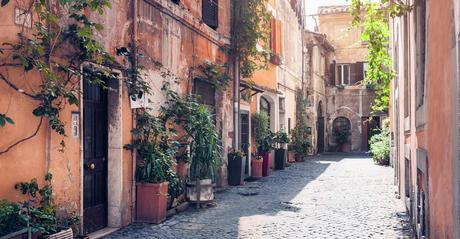
Trastevere is not a classic attraction in Rome. It’s rather a beautiful little neighborhood that looks like a village and lets you forget for a few hours that you’re in one of Europe’s largest cities. There are no museums and statues in Trastevere. Instead, you want to visit the district for its romantic charm.
It’s a lot of fun to stroll through the narrow streets and browse through the small authentic shops that still exist here. Take a look not only at the two main streets, but also explore the small streets away from the mainstream tourism. At night, the Trastevere turns into a bustling nightlife district, where you first enjoy a cocktail, then go to the trattoria and end up enjoying a drink or two on the terraces of the many cafes and bars. A must see for all who visit Rome!
How to get there: Trastevere is located on the west side of the river Tiber in the 13th district (the Romans call their districts “rioni” (pl.)). Click here to navigate to Trastevere.
Victor Emmanuel II National Monument
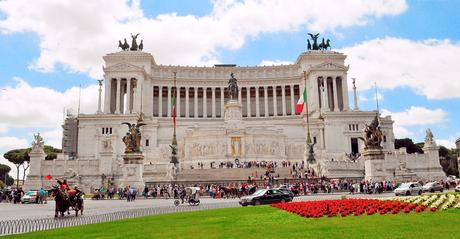
This monument is located in the heart of Rome, not far away from the Colosseum and Forum Romanum, at the south side of Piazza Venezia. It’s Italian name is Monumento Nazionale a Vittorio Emanuele II. As the name says, it was built for the first king of united Italy, Victor Emmanuel II. But this complex also preserves the Altar of the Fatherland which has a great representative value. Due to this fact, the whole monument of Victor Emmanuel II is often erroneously called “Altar of the Fatherland” (ital.: Altare della Patria).
For many years, Italy was divided into city-states and principalities, which were often toys foreign European powers. Inspired by the idea of the French Revolution, a new national consciousness and the urge for a geographical unification of the country gradually began to germinate in the liberal and democratically minded bourgeoisie. The turbulent years, which came to an end in the year 1861 with the appointment of Victor Emmanuel II as King of Italy, are known as Risorgimento.
The monument was erected between the years 1885 and 1935. But it was already inaugurated in the year 1911. At the front of the monument you will find a large statue of Emmanuel together with several other sculptures.
Because of its shape, the Italians are calling this monument jocularly “typewriter” (ital.: Macchina da scrivere), and sometimes “wedding cake” (ital.: Torta nuziale).
What will you get there:
You can visit the monument for the king and the museum (middle platform). If you would like to get higher to the roof of the monument, you need to pay a charge to use the elvator (the only possibility how to get there). It’s 7,- EUR for adults and 3,50 EUR for kids and teens between 10 and 18 years.
How to get there:
If you take the Hop-of Hop-off bus, it will stop not war away from this monument so you will have to walk just a couple of minutes. Click here to navigate there.
Piazza del Popolo
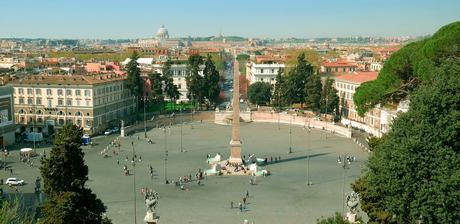
Translated, Piazza del Popolo means “square of the people”, and it’s one of the most famous squares in Rome. The Basilica of Santa Maria del Popolo gave the piazza its name. But actually, the name derives from the poplars (just mentioning in passing).
According to the legend, this baroque church was built on the tomb of Emperor Nero, who got a reputation as a persecutor of Christians. Therefore, this place at the basilica was avoided by the Romans in the Middle Ages, because people were convinced that the spirit of Nero was haunting there.
Piazza del Popolo is surrounded by other historical buildings like the church Chiesa di Santa Maria dei Miracoli, Portal del Popolo, or the Basilica Prrocchiale. In the center of the Piazza del Popolo, you will find an Egyptian obelisk which was brought to Rome from Egypt in the year 10 BC. Originally, it was set up in the Circus Maximus but was moved to Piazza in the year 1589 by order of the Pope Sixtus V. The twin churches of Santa Maria in Monte Santo and Santa Maria dei Miracoli complete the ensemble of remarkable buildings in Piazza del Popolo. Maybe you already have seen them in the movie “Angels & Demons” with Tom Hanks.
How to get there:
The Hop-on Hop-off bus stops close to Piazza del Popolo, folks. Alternatively, you can walk there from the Spanish Steps which will take you about 10 minutes. Click here to navigate there.
Baths of Caracalla
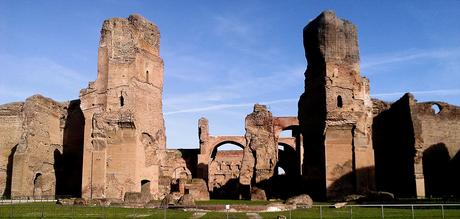
The Baths of Caracalla were Rome’s second largest public baths. It’s not fully clear, but they were probably commissioned by the emperor Septimius Severus, and they were inaugurated in the year 216 AD. Back those times, the Baths of Caracalla were regarded as the one of the seven wonders of Rome. Allegedly, this place had a capacity of 1600 visitors and it served as an inspiration for several other constructions, even in the modern times. Two of them for example are the Chicago Union Station and the Pennsylvania Station in New York.
All of the baths (or thermae) in Rome had two main functions: for sanitation and as a meeting point for people, to socialise if you will. The complex also contained two gyms (palestra), two libraries with Greek and Latin “books” (scrolls), and several shops (tabernae).
Originally, the baths were equipped with sculptures (estimated 120 of them), and they seemed to be pretty lavishly produced. Unfortunately, most of them were destroyed in the Middle Ages by city residents to make lime of them. Luckily, those of them which survived, were excavated in the 16th century to serve as decorations in some new built palaces in Rome. Nowadays you will find them in some museums in Italy, like the National Archeological Museum of Naples.
The Baths of Caracalla were in usage until the 530s AD. After this period, they fell into disuse and were left to fell into disrepair.
What can you do there?
You can visit the Baths of Caracalla by a guided tour. Doing this you will get some fascinating information about the baths themselves and you will also learn how the temperature of the water was controlled by the slaves. In case you want to visit Rome during the summer time, you can also attend some live events, like an opera in the central part of the complex.
How to get there:
Take the Hop-on Hop-off bus and leave it either at Colosseum or at Circus Maximus. Then you would need to a walk a bit as this place. From Colosseum, it would take you about 18 minutes of walking. From Circus Maximus, about 13 minutes. Click here, to navigate there.
The historical protestant cemetery
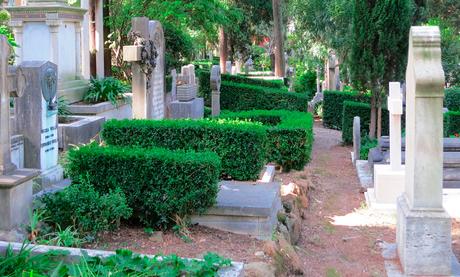
The Protestant cemetery in Rome is perhaps considered one of the most idyllic places in the whole city. At first glance, this might sound a bit morbid, but it’s all about history and the architecture of the cemetery that grew out of it. Amidst of the many tombs of known and unknown people, it’s also about the splendor of some of the last resting places that attracts so many visitors to the Protestant cemetery. And last but not least, there are the cats, who have been the silent guardians of this special place for several decades.
In former times, Rome was more than just the Holy City. Even in the late Middle Ages and early modern times, it was the religious, spiritual, and political power center of the Papal State of Europe. Catholicism played an important role here for many years; even when the Reformation had prevailed in Germany and other European countries.
As a result, there were many people from other countries inside the Roman walls who didn’t belong to the Catholic religion. But due to the dominant power of the Catholic Church in Rome, it was out of the question that these, in its eyes infidels, would be buried in the catholic cemeteries of Rome. Therefore, an alternative place had to be found.
That’s how the Protestant cemetery got its name. But actually, it wasn’t just for Protestants but for all foreigners who did not have the Catholic denomination and passed away in Rome. The first graves were placed right next to the Cestius pyramid (more about the pyramid you will read below). But this place wasn’t yet an official cemetery. That came gradually as this former “graveyard” grew little by little.
After the Protestant cemetery got its official role as a cemetery when the Papal State ended, this place received its official role. Then, it got not only another space extension, but also its chapels.
What will you get at the Protestant cemetery in Rome?
Over the years, a unique piece of history has been created here. And the fact that the cemetery officially didn’t exist for many years, surrounds it with a special aura. Especially passed away European artists are visited here by their fans of modern times. But it’s not just the personalities who making the cemetery what it is.
With the standing of the buried, the graves themselves became important. For the cemetery is not just a hotchpotch of different tombs but a collection of works of art. This is also because at the time of the Papal State no crosses or similar symbols of religion were used on the tombs.
In order to have a pompous grave nevertheless, the decedents have become creative during their lifetime. They created mausoleums, frescoes and marble paintings for those who passed away.
The next what you can expect, are the many stray cats are living at the Protestant cemetery serviced by volunteers. They are considered the guardians of this wonderful historic place. It’s probably the peace and tranquility behind the walls, the seclusion and the peaceful atmosphere that made them appreciate this cemetery as much as the human visitors.
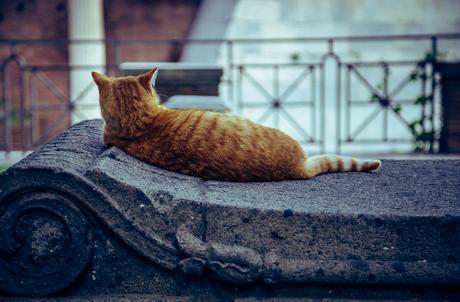
How to get there:
This cemetery is not located along the touristic routes, and you will need to take a taxi or the Metro, Line B. When you take the metro, leave it at the station “Piramide”. Alternatively, you can also take the tram, Lines 3 and 8. Leave it at the stop called “Porta San Paolo”. Then click here, to navigate there, folks. It would take you about 5 minutes of walking.
Entrance fee:
The entrance is for free. But there is a donation box you can put some change into it. It’s for the cats and for the costs of maintenance. You can also buy some books of the portraits of the cats living there.
The secret pyramid of Cestius

When you decide to visit the Protestant cemetery, you will automatically get another impressive attraction which is the Cestius pyramid.
In my eyes, the Protestant cemetery and the pyramid are typical attractions for those who are looking for things to do in Rome but also would like to visit some places that are a bit off the usual tourist trails.
Pyramids are usually associated with the ancient Egypt. But in the time of the Roman Emperor Augustus, Egypt was in the year 30 BC not an independent country but a conquered province of the Roman Empire. And guess what: Egyptian architecture was extremely popular in Rome at that time, with less focus on the classical buildings of the pharaohs, but rather on the so-called Ptolemaic structures.
In total, there were four pyramids built in Rome. But only the Cestius pyramid survived. In addition, the Romans integrated the exotic structure from the year 271 AD into the Aurelian Wall.
The pyramid of Rome was built in the years 18 to 12 BC on behalf of the Roman tribune and praetor Gaius Cestius Epulo, to whom the pyramid would serve as a burial place. There is not much known about his life so his tomb is one of the few traces of this praetor. He died in the year 12 BC.
In front of the pyramid, there were four columns. All of them decomposed but two of them were found in the ground adjacent to the pyramid in the year 1656 during the restoration of the pyramid and re-erected later.
In the Middle Ages, the pyramid had the name “Grave of Remus”. It formed the counterpart to another pyramid at the Castel Sant’Angelo, which received the name “grave of Romulus” but was demolished in the year 1499 to create more space for access to the Vatican.
Nowadays, you can admire the pyramid of Rome from outside but also from inside!
How to get there:
When you visit the Protestant cemetery, you will automatically visit the pyramid, folks.
Entrance fee:
Although the access to the Protestant cemetery is for free, you will need to pay to access the pyramid. It’s 5,50 EUR for adults plus 2,- EUR reservation fee. The pyramid is not every day opened but only on every 2nd, 3rd and fourth Saturday in the month. Besides that, you need to make a phone call and ask for a reservation: (+39 06 399 67 700).
If you ask me, this is a good way to keep this place calm and prevent it of masses of tourists. Only those, who are really interested in it, will come here. It was one of my best experiences and one of the best things to do in Rome, folks.
Capuchin crypt of Rome
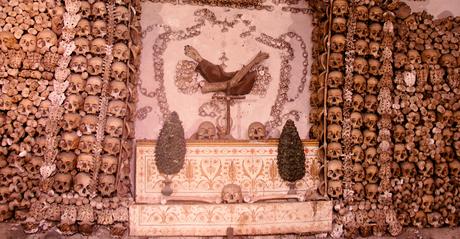
If you have a sense for obscure and scary things, you should visit this place. Close to Piazza Barberini, there is the church Santa Maria Immacolata a Via Veneto. This simple looking building holds a secret in its crypt: bones over bones. The so-called Crypt of the Capuchins is one of the most unusual and uncanny things do do in Rome.
Originally, it was a normal church of a Capuchin monastery located outside the city; here, the monks have found their peace and a place for prayers. The highlight of this church, the skulls and bones, was created after the death of those monks. In other words, these remains were those monks you can see now in several chapels inside of the church.
Without question, the bone crypt of Santa Maria della Concezione is one of the strangest things to see in Rome. However, you can be sure that this attraction is one of those you will not get in many other places of the world. Therefore, if you want to experience Rome in a different way, visit the Capuchin Crypt in any case!
I planned to shoot some photos for this article but on entering the building, I saw signs saying “No Photos”. The lady at the reception had mentioned the ban again. Too bad because the crypt is very impressive and would make a great photo opportunity.
Taking pictures secretly wasn’t possible, too. For inside, there are guards keeping an eye on the visitors and everything is video-monitored. Therefore, I had to take the images from Wikipedia.
How to get there:
When you take the Hop-on Hop-off bus, you should leave the bus either at the Spanish steps or at the Borghese gardens. From those places, it’s not very far away to walk to the crypt. Click here to navigate there.
Entrance fee:
8,50 EUR for adults. Retired persons (65+) and teens (18-) pay 5,- EUR. Unfortunately, the Rome pass is not valid at this place.
You can also get a guided tour for about 30,- EUR which will take about 40 minutes. If you ask me, too short for this stunning place, but I enjoyed it a lot nevertheless, and can recommend you to do this, folks.
Catacombs of Rome
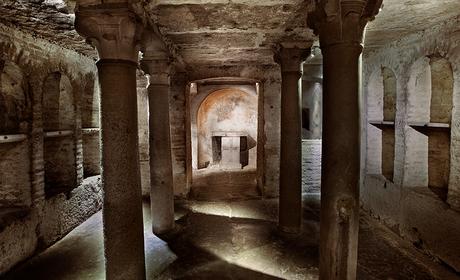
For me, the Catacombs of Rome are amongst the most extraordinary tourist attractions in Rome, folks. Rome is full with historic buildings, places and sights. In the “Eternal City”, you can almost smell the vivid history. And you will find this history, among other things, in those old catacombs.
In total, there are four catacombs in Rome. Three of them are located near the Via Appia Antica / Appian road: the Catacombs of Calixtus, the catacombs of Sebastian, and the catacombs of Domitilla. In the north of the city there is another underground network: the Priscilla catacombs. The best known are the two first-mentioned: Calixtus and Sebastian catacombs which you could visit on the same day as they are located not far from each other. What are these catacombs? The catacombs are underground passages and galleries where Christians buried their dead. Because of reasons of hygiene, it was forbidden in ancient Rome to bury the deceased within the city walls. The Roman noblemen were cremated and their ashes kept in urns in magnificent tombs along the consul streets. Christians, however, buried their dead in underground grots. One reason was that they believed in the resurrection. They also used these catacombs as hiding places at the time when they were persecuted. So actually, those catacombs were Necropolises. They just known as Catacombs today.Calixtus catacombs
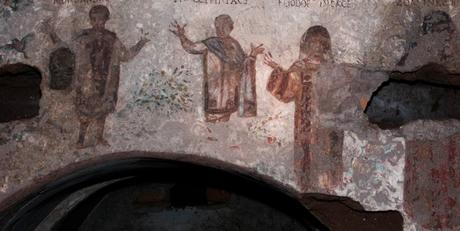
Sebastian catacombs
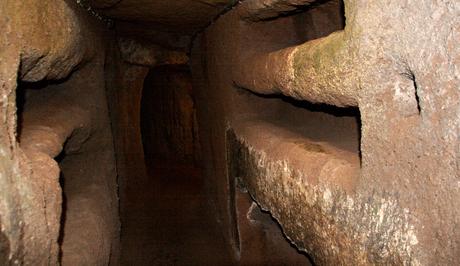
Opening hours and entrance fee for the Calixtus catacombs: 9 a.m. to 12 a.m. and 2 p.m. to 5 p.m. On Wednesdays it’s closed. The catacombs are also closed on the following days: Easter Sunday, December 25th and January 1st. For Sebastian catacombs: 10 a.m. to 5 p.m. from Monday to Saturday. The last admission will be at 4:30 p.m. On Sundays it’s closed. Attention: The catacombs will be closed in December. Also, on January 1st, the doors remain closed. Entrance fee: There is same entrance fee for both catacombs: 8,- EUR for adults; 5,- EUR for kids and teens between 7 and 15 years. There are also guided tours available (30- to 40-minutes) in 5 languages. The tours begin as soon as enough people of one language have gathered.
Domitilla catacombs
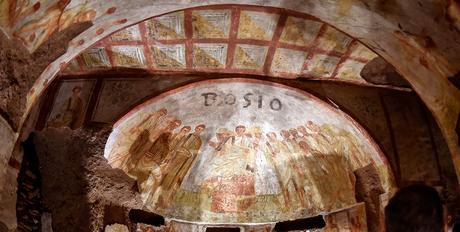
Opening hours and entrance fee:
The Domitilla catacombs are closed on Tuesday. During the other days, the opening hours are: 9 a.m. to 12 a.m. and 2 pm to 5 pm. The entrance fee is 8,- EUR for adults and 5,- EUR for children up to 15 years. Children under 7 years may visit the catacombs free of charge. Guided tours are offered every day, starting as soon as enough guests have arrived.
Priscilla catacombs
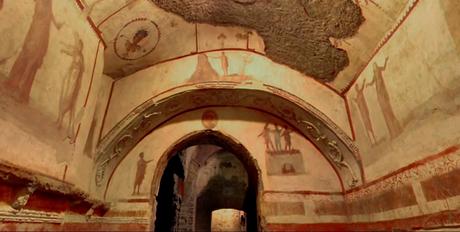
Opening hours and entrance fee: The entrance fee for is 8,- EUR for adults. Teenagers between 7 and 15 years pay 5,- EUR. Children up to 6 years can visit the catacombs for free. There are regular opening hours. But it could nevertheless happen that you arrive there and this place is closed. Therefore, you should write an e-mail to make sure that the catacombs are open for sure on your preferrable day: [email protected].
The opening hours are Tuesday to Monday 9 a.m. to 12 p.m. and 2 p.m. to 5 p.m. On Monday it’s closed.
Church Santa Maria Maggiore
